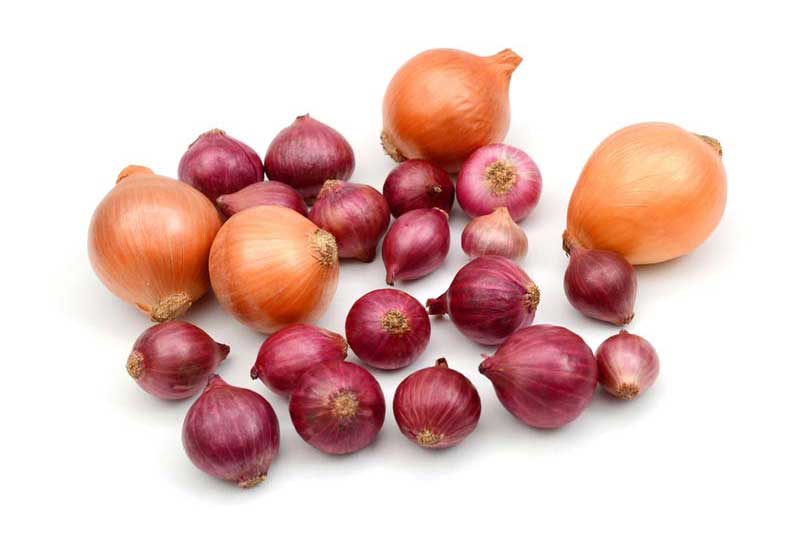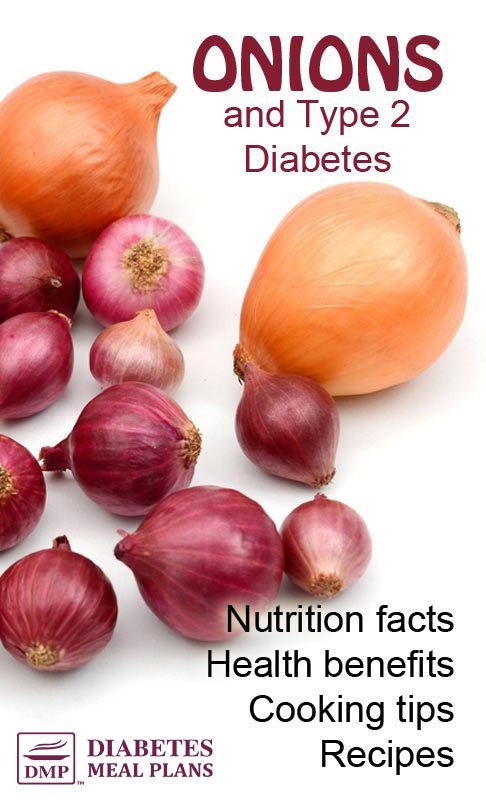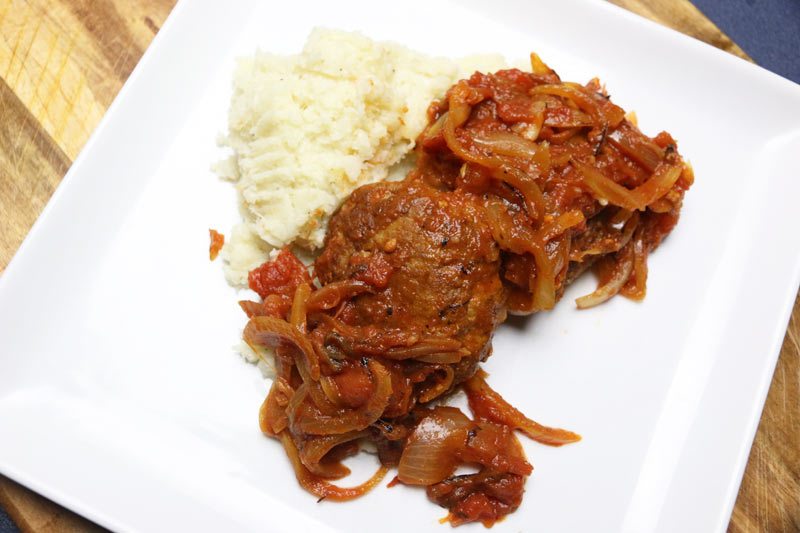Table of Contents[Hide][Show]
The beloved onion — the painful tears they elicit while cutting are well worth the amazing flavor and aroma they provide for just pennies per serving.
Onions find themselves in the same “bulb” plant family along with garlic, scallions, leeks, and shallots. They all have similar nutritional profiles and provide a multitude of health benefits, largely due to their sulfur containing compounds.

Onions may be white, yellow or red and can vary in flavor from mild to strong and from sweet to spicy. They have been used for centuries both medicinally and, of course, culinarily. And they are a wonderful asset to a healthy diet, including a type 2 diabetic diet.
Onion Nutrition Facts
- Onions are very low in calories – having only 40 calories per 100 grams (or 64 calories per cup chopped)
- Onions are a decent source of fiber – nearly 2 grams per serving
- Onions are an great source of many B vitamins and vitamin C
- Onions provide several minerals including potassium
- Onions contain flavonoids and sulfur compounds
- Onions are considered low glycemic index with a value of only 10
Health Benefits of Onions
- B vitamins are crucial for cell growth, metabolism, healthy skin and hair
- Vitamin C is an antioxidant that strengthens immunity and promotes healthy skin and hair
- Potassium is heart healthy and can help lower blood pressure
- Fiber is key to healthy digestion and lipid control
- Flavonoids promote heart health while sulfur compounds help prevent against cancer
Research on Onions Specific to T2 Diabetes
Onions can help reduce inflammation, an underlying cause of diabetes as well as many other metabolic issues.
Onions have been shown to have antidiabetic effects as well as reduce cardiovascular disease.
They seem to lower blood sugar in animal studies and have even been shown to do so in one human study. It’s probably due to the fact they are a prebiotic food. Prebiotics are undigested fibers that pass through the upper digestive tract to the large intestine where they stimulate growth of beneficial bacteria. And surprisingly, gut bacteria are involved in glucose regulation!
They also have antimicrobial properties, protect against infection which occur at higher rates with diabetes.
Antioxidants in onions have free radical properties that help to reverse cell damage.
Onions seem to have a positive effect on bone health perhaps even reducing risk for osteoporosis.
Sulfur containing compounds in onions have been linked to reduced risk for: breast, colon, prostate, stomach, ovarian, and oral cancer.
Pretty great benefits overall!
Points for Consideration
Onions contain fructans–a source of soluble prebiotic fiber. While these are not inherently problematic (they are super good for most people), for some with IBS who struggle with digesting certain types of carbohydrates, fructans may be a source of GI upset. If following FODMAPS approach, you may want to limit onions.
Due to sulfur content in onions, they can be gas-producing and odorous. While this is not a health concern, it may be a social concern for some.
Onions hurt! Let’s face it… most of us who have ever cut one have shed some painful tears. This is because cut onions release a gas that irritates glands in the eyes. Cut open onions can be irritating to the skin as well. There are a couple strategies to combat this (see below).
Finally, while there are generally only mild concerns with onions for humans (unless a true allergy), keep in mind that onions are toxic to most animals. Do not feed them cooked or raw to your pets.
Onions and Diabetes Conclusion
Onions are a great low calorie, flavorful addition to a wide variety of dishes. They can be readily found year round, are very inexpensive, and have a long storage life. Take some precautions when cutting and start adding them in as you cook!

Onions in the Kitchen
Selection
Choose onions with crisp skin and without blemishes, bruises or soft spots. Avoid any that are starting to sprout or have discolored signs of mold.
Storage
Store onions in a cool dry location with good circulation such as a root cellar. Avoid storing in the same location as potatoes as they will absorb their moisture causing them to spoil more quickly.
Uses
Onions are most frequently an initial saute ingredient for the beginning of a dish–stir fries, chili dishes, soups, casseroles, etc. However, they can also be roasted or boiled.
The brown/yellow onions are a savory ingredient, usually cooked, but red onions are often served raw in salad and green onions are frequently used as a garnish or topping for cooked dishes.
Cooking
Steam onions 10-15 minutes
Boil onions 7-10 minutes
Roast onions 45-60 minutes
Grill onions 15-20 minutes
Tips to stop the onion tear-up
Cutting onions is tricky. Not only do they easily slide around, but as soon as you cut into them, you’re likely to tear up.
Here are a few hacks:
1. Refrigerated onions are less likely to elicit tears.
2. Leaving the root in tact (where the majority of the tear-causing gas is found) may help.
3. Cutting under cold water can help, but this may also increase odds of your knife slipping and cutting yourself.
4. Some claim sticking your tongue out, chewing gum or putting bread in your mouth helps… but since bread is pretty high carb, we don’t advocate that one!
5. My favorite: onion goggles. These seal over your eyes and protect you from the gases released. I use them every time and they’re well worth the investment they last for years.
Keep in mind that the more you reduce your exposure to the cut onions, the easier it will be–so either cover them up or cook them right away.
Onion Cutting Techniques
The best way to cut an onion is to slice about ½” off the top, then cut the onion in half (leave the root intact).
Place the onion sliced side down on the cutting board and make several cuts close to the root, but not through it. If you need slices only, you can stop at this point and just cut the root off. Then turn the onion around and slice the other direction into whatever size you need for your dish – still keeping the root in tact as this will help keep the onion together. When you get to ½” of the root just toss it and do the same with the other half.
Here Gordan Ramsay demonstrates how to finely dice an onion.
Here’s another video that demonstrates several ways to cut onions.
Onion Recipes
You can basically add onion to any dish. Give these few dishes a try.
- Low Carb Beef Goulash
- Creamy Mustard Chicken Noodles
- Sugar Free Sweet Chili Sauce
- Cheesy Vegetable Bake
Or alternatively, you can feature onions, such as these two delicious dishes:
Caramelized Onions with Turkey Patties

HAPPY EATING!

Susan Hose
On the Glycemic Index, Onions are listed at 10 …. Then again at 70 ? Please explain and thank you !
Dr Jedha - Nutritionist (PhD)
As far as I can see, they are only listed once at 10.
clavel
is raw onion ok
Jedha
Yes Clavel, raw onion is fine. The red ones are sweet in salads!
Tony G.
thanks for tips regards onion . To God be the Glory !